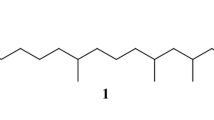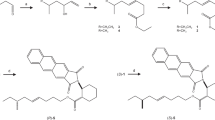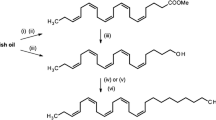Abstract
Lipidic extracts of Spodoptera littoralis pheromone glands submitted to acid methanolysis using: (i) sulfuric acid/methanol/benzene (0.1∶4∶2, by vol) at 90°C for 1 h; (ii) 12 N HCl/methanol (1∶2; vol/vol) at 90°C for 1 h, or (iii) 14% BF3-MeOH at 90°C for 1 h did not reveal the presence of either 11- or 12-hydroxytetradecanoic acid in the extracts, as concluded from the gas chromatography-mass spectrometry analyses. Under the above methanolysis conditions, a synthetic sample of methyl (14, 14, 15-2H3) 12-hydroxytetradecanoate remained unaltered. These results may indicate that formation of (E)-11-tetradecenoic acid from tetradecanoic acid does not occur in the pheromone gland by dehydration of an intermediate hydroxyacid. Acid methanolysis of a lipidic extract using BF3-MeOH led to the formation of a mixture of methoxy fatty acid methyl esters, identified by gas chromatography-mass spectrometry. These methoxy derivatives should arise from BF3-catalyzed addition of methanol to the double bond of the natural monounsaturated fatty acyl derivatives present in the gland. Thus, under the same conditions, a synthetic sample of methyl (Z)-11-tetradecenoate was partially transformed into methyl 11-methoxytetradecanoate and methyl 12-methoxytetradecanoate. This reaction might be a useful alternative procedure to obtain methoxy derivatives of olefins, which are very helpful for the structural characterization of the parent alkenes.
Similar content being viewed by others
Abbreviations
- FAME:
-
fatty acid methyl esters
- GC-MS:
-
gas-chromatography coupled-mass spectrometry
- 11-MeO-16:Me:
-
methyl 11-methoxyhexadecanoate
- 12-MeO-16:Me:
-
methyl 12-methoxyhexadecanoate
- 9-MeO-14:Me:
-
methyl 9-methoxytetradecanoate
- 10-MeO-14:Me:
-
methyl 10-methoxytetradecanoate
- 11-MeO-14:Me:
-
methyl 11-methoxytetradecanoate
- 12-MeO-14:Me:
-
methyl 12-methoxytetradecanoate
- Z11-14:Me:
-
methyl (Z)-11-tetradecenoate
References
Roelofs, W.L., and Bjostad, L. (1984) Biosynthesis of Lepidopteran Pheromones, Bioorg. Chem. 12, 279–298.
Dunkelblum, E., and Kehat, M. (1987) Sex Pheromone Precursors in Spodoptera littoralis (Lepidoptera: Noctuidae), Insect Biochem. 17, 877–881.
Martinez, T., Fabrias, G., and Camps, F. (1990) Sex Pheromone Biosynthetic Pathway in Spodoptera littoralis and Its Activation by a Neurohormone, J. Biol. Chem. 265, 1381–1387.
Templier, J., Largeau, C., and Casadevall, E. (1991) Nonspecific Elongation-Decarboxylation in Biosynthesis of cis- and trans-Alkadienes by Botryococcus braunii, Phytochemistry 30, 175–183.
Van De Loo, F.J., Broun, P., Turner, S., and Somerville, C. (1995) An Oleate 12-Hydroxylase from Ricinus communis L. Is a Fatty Acyl Desaturase Homolog, Proc. Natl. Acad. Sci. USA 92, 6743–6747.
Shanklin, J., Whittle, E., and Fox, B.G. (1994) Eight Histidine Residues Are Catalytically Essential in a Membrane-Associated Iron Enzyme, Stearoyl CoA Desaturase, and Are Conserved in Alkane Hydroxylase and Xylene Monooxygenase, Biochemistry 33, 12787–12794.
March, J. (1985) Advanced Organic Chemistry. Reactions, Mechanisms, and Structure, 3rd. edn., pp. 681–682, John Wiley & Sons, New York.
Bjostad, L.B., and Roelofs, W.L. (1984) Sex Pheromone Biosynthetic Precursors in Bombyx mori, Insect Biochem. 14, 275–278.
Blomquist, G.J., Howard, R.W., McDaniel, C.A., Remaley, S., Dwyer, L.A., and Nelson, D.R. (1980) Application of Methoxymercuration-Demercuration Followed by Mass Spectrometry as a convenient Microanalytical Technique for Double-Bond Location in Insect-Derived Alkenes, J. Chem. Ecol. 6, 257–269.
Vostrowsky, O., Michaelis, K., and Bestmann, H.J. (1981) Methoxymercurierung-Demercurierung zur Bestimmung der Doppelbindungspositionen Doppelt Ungesättigter Lepidopteren-Pheromone, Liebigs Ann. Chem. 1721–1724.
Vulliet, P., Markey, S.P., and Tornabene, T.G. (1974) Identification of Methoxy Artifacts Produced by Methanolic-HCl Solvolysis of Cyclopropane Fatty Acids of the Genus Yersinia, Biochim. Biophys. Acta 348, 299–301.
Navarro, I., Fabrias, G., and Camps, F. (1996) Synthesis of (14,14,14-2H3) 12-Hydroxytetradecanoic Acid and (13,14-2H2) 11-Hydroxytetradecanoic Acid Useful Tracers to Study a E-11 Desaturation Reaction in Spodoptera littoralis, Bioorg. Med. Chem. 4, 439–443.
Author information
Authors and Affiliations
About this article
Cite this article
Navarro, I., Fabriàs, G. & Camps, F. Possible fatty acyl pheromone precursors in Spodoptera littoralis. Search for 11- and 12-hydroxytetradecanoic acids in the pheromone gland. Lipids 32, 407–412 (1997). https://doi.org/10.1007/s11745-997-0052-x
Received:
Revised:
Accepted:
Issue Date:
DOI: https://doi.org/10.1007/s11745-997-0052-x




